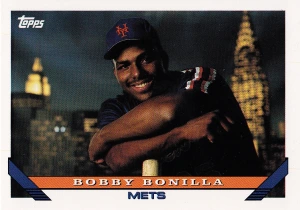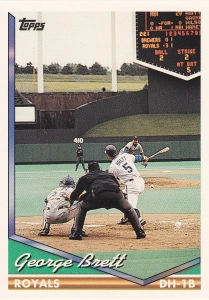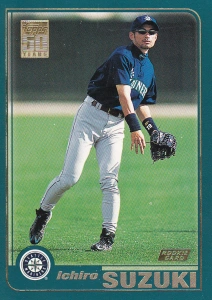Before I started doing all this retro stuff on this blog, I had actually completed another set. Actually, a bunch of sets, but this was the first one – 1989 Topps. I actually finished this back in February, so I’ve been slacking a bit about getting this post done. Heritage, Gypsy Queen, Allen & Ginter, Archives, Goodwin (and soon, Topps Mini) will do that to you… I haven’t finished off the “Master Set” quite yet – basically because getting to 1989 means I’ve reached the point where there are some insert sets now. In fact, for 1989 and 1990 it will be some time before I can finish off the Master Sets. Why? Because I’m going for the K-Mart “Batting Leaders” inserts that are obscure and difficult to find for a fair price.
Info about my set:
How I put the set together:
- 410 cards from the wax box
- 296 cards from a lot of jumbo packs
- 86 cards from trades
Card that completed my set: #393 – Gary Carter AS (1 of 5 cards I got in a trade from Scott Crawford on Cards that completed the set)
 Set composition: 792 cards (690 individual ML player cards*, 10 #1 Draft Picks, 26 Managers, 5 Turn Back the Clock, 6 Checklists, 7 Record Breakers, 22 All-Stars, 26 Team Leaders) *The 690 individual player cards include 10 All-Star Rookies and 5 Future Stars
Set composition: 792 cards (690 individual ML player cards*, 10 #1 Draft Picks, 26 Managers, 5 Turn Back the Clock, 6 Checklists, 7 Record Breakers, 22 All-Stars, 26 Team Leaders) *The 690 individual player cards include 10 All-Star Rookies and 5 Future Stars
Representation of ’88 MLB season: The 690 players represent 70.9% out of the ~973 players who played in MLB in 1988.
Last active player from this set: #717 – Jamie Moyer
 Moyer would have been the last active player from this set even if he hadn’t come back in 2012.
Moyer would have been the last active player from this set even if he hadn’t come back in 2012.
Player with the most cards in the set: Orel Hershiser – 4 cards: Hershiser – #550, #5 (Record Breaker), #394 (All-Star), #669 (Team Leaders)
 There were quite a few with various combinations of 3 cards, but Hershiser was the only player featured on all 3 subsets in addition to his base card.
There were quite a few with various combinations of 3 cards, but Hershiser was the only player featured on all 3 subsets in addition to his base card.
First Card and the Hundreds: #1 – George Bell RB, #100 – Mike Schmidt, #200 – George Brett, #300 – Darryl Strawberry, #400 – Alan Trammell AS, #500 – Jose Canseco, #600 – Wade Boggs, #700 – Don Mattingly
 Highest book value: #49 – Craig Biggio RC
Highest book value: #49 – Craig Biggio RC
 Most notable card: #647 – Randy Johnson RC (rated #54 in Topps vote of 60 best cards)
Most notable card: #647 – Randy Johnson RC (rated #54 in Topps vote of 60 best cards)
 This card narrowly beats out Mike Schmidt’s last card.
This card narrowly beats out Mike Schmidt’s last card.
Best card (my opinion): #100 – Mike Schmidt
 This isn’t the best set out there, and there aren’t a ton of notable or recognizable cards. The Griffey RC from the Traded set beats out any cards from the base set. But I’ll take Schmidt’s last base Topps card over the first cards of Biggio, the Big Unit or some of the others. Plus, it’s a pretty good picture of the greatest 3rd baseman ever – a good way to go out!
This isn’t the best set out there, and there aren’t a ton of notable or recognizable cards. The Griffey RC from the Traded set beats out any cards from the base set. But I’ll take Schmidt’s last base Topps card over the first cards of Biggio, the Big Unit or some of the others. Plus, it’s a pretty good picture of the greatest 3rd baseman ever – a good way to go out!
Second best card (also my opinion): #440 – Bobby Bonilla
 Staying in the state of Pennsylvania – I just really like this card. It’s close enough up to see detail, but just far enough away to see a good picture.
Staying in the state of Pennsylvania – I just really like this card. It’s close enough up to see detail, but just far enough away to see a good picture.
Best subset card: #5 – Orel Hershiser
 It’s a pretty good photo, but more importantly, this card represents one of the truly great records of all-time. Not only that, but the way Orel broke Don Drysdale’s record for consecutive scoreless innings is the stuff of legends. The record came over the last month of the season, when the Dodgers really needed the wins to get to the postseason. In his last start of the season, he needed to go over 9 scoreless innings to tie Drysdale’s record. He threw the scoreless 9 innings, and his Dodger hitters played their part – scoring no runs so Hershiser could throw one more inning, which he did. He broke Drysdale’s record, and he led the Dodgers to the World Series title that year. This card beats out the Hank Aaron card from the Turn Back the Clock and the Padres TL card below.
It’s a pretty good photo, but more importantly, this card represents one of the truly great records of all-time. Not only that, but the way Orel broke Don Drysdale’s record for consecutive scoreless innings is the stuff of legends. The record came over the last month of the season, when the Dodgers really needed the wins to get to the postseason. In his last start of the season, he needed to go over 9 scoreless innings to tie Drysdale’s record. He threw the scoreless 9 innings, and his Dodger hitters played their part – scoring no runs so Hershiser could throw one more inning, which he did. He broke Drysdale’s record, and he led the Dodgers to the World Series title that year. This card beats out the Hank Aaron card from the Turn Back the Clock and the Padres TL card below.
Favorite action photo: #231 – Padres TL (R. Alomar)
 There really aren’t very many action cards in this set – in fact, the Team Leaders by far have the best action shots. This one features Roberto Alomar sliding around Gary Carter at the plate. This beats out the Royals TL card which features a pretty cool action shot of Bo Jackson in the outfield.
There really aren’t very many action cards in this set – in fact, the Team Leaders by far have the best action shots. This one features Roberto Alomar sliding around Gary Carter at the plate. This beats out the Royals TL card which features a pretty cool action shot of Bo Jackson in the outfield.
Favorite non-action photo: #55 – Julio Franco
 The Bonilla could win this one, too, but I also really liked this card of Julio Franco – you’ve got the eye black as he looks on in the dugout. Cool card.
The Bonilla could win this one, too, but I also really liked this card of Julio Franco – you’ve got the eye black as he looks on in the dugout. Cool card.
My Favorite Reds card: #330 – Eric Davis
 This was a really tough pick. I like this card of my favorite player from that time – Eric Davis. It’s a really good shot of him after going the other way. Larkin has a really good card, too, with him in a similar pose. And the last Topps card of manager Pete Rose, who would be banished from the game shortly after this set was released.
This was a really tough pick. I like this card of my favorite player from that time – Eric Davis. It’s a really good shot of him after going the other way. Larkin has a really good card, too, with him in a similar pose. And the last Topps card of manager Pete Rose, who would be banished from the game shortly after this set was released.
Topps Reprints and others:
- 1999 Ryan reprints – Nolan Ryan
- 2001 Through the Years – Ryne Sandberg
- 2001 Archives – Bruce Sutter, Mike Schmidt, Ron Guidry, Willie Hernandez, Tommy John, Wade Boggs RB, Andre Dawson RB
- 2001 Archives Rookie Reprints – Randy Johnson, Gary Sheffield
- 2001 Topps Traded – Ken Griffey Jr. (’89T), Deion Sanders (’89T), Nolan Ryan (’89T)
- 2002 Archives – Bo Jackson, Will Clark, Kevin Mitchell, Frank Robinson MG
- 2003 Gallery Heritage – Johnson
- 2005 Rookie Cup Reprints – Jay Buhner, Chris Sabo, Ron Gant, Mark Grace, Walt Weiss
- 2005 Gallery Heritage – Griffey Jr. (’89T)
- 2010 CMT – Sheffield, Johnson, Craig Biggio
- 2011 60YOT – Bo Jackson TL, Paul Molitor
- 2012 Tier One Autographed Rookie Reprint – Griffey Jr. (’89T)
- 2013 Rookie Card Patch – Griffey Jr. (’89T)
With the inserts in 2012 and 2013, Griffey now has 4 reprints to pass the 3 that Big Unit has.
Other Notable Cards: #505 – Pete Rose MG, #233 – Gregg Jefferies RC, #343 – Gary Sheffield RC  I mentioned the Rose last Topps card above, but the Gregg Jefferies rookie was a pretty big deal in 1989. And Sheffield’s rookie card was another winner from the Future Stars subset.
I mentioned the Rose last Topps card above, but the Gregg Jefferies rookie was a pretty big deal in 1989. And Sheffield’s rookie card was another winner from the Future Stars subset.












































































